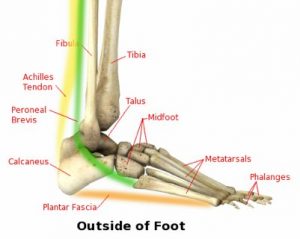Ankle Dorsiflexion:
 The Plantar Fascia gets blamed for a lot of foot pain. Usually this is with good reason. Much of the foot pain that is seen clinically occuring on the plantar side of the foot (bottom) is due to inflammation within the Fascia. This is almost always due to a biomechanical issue somewhere else in the body.
The Plantar Fascia gets blamed for a lot of foot pain. Usually this is with good reason. Much of the foot pain that is seen clinically occuring on the plantar side of the foot (bottom) is due to inflammation within the Fascia. This is almost always due to a biomechanical issue somewhere else in the body.
By definition, Fascia is simply connective tissue. It is not a ligament or a tendon, rather it has several origins and insertions and attempts to hold tissue together and in place. It is not like muscle, because it doesn’t have the ability to shorten and does not have the same blood flow and neurological innervation. Thus, it can become painful and inflammed, but it can’t really be stretched effectively.
The concept of stretching fasia as been around for a long time, but it is easily discounted when you truly understand what you are trying to do with stretching and flexibility training. Flexibility training requires a very active neurological system which is only present in muscle. Without the neurological system to overload and desensitize, there will be no gains in flexibility or mobility. So, attempting to stretch fascia is essentially a waste of time.
Effect of Dorsiflexion on Plantar Fascia
Poor dorsiflexion, whether caused by a restricted ankle joint or poor Gastroc/Soleus flexibility will place an extra stress on the Plantar Fascia. This restricted movement will essentially force the athlete to stay on their toes and keep the Plantar Fascia stressed throughout the day. Increasing dorsiflexion allows an athlete to do more with their heels on the floor, providing a much needed break for the Plantar Fascia.
At the end of the day, Plantar Fascia pain and problems almost always starts somehere else in the body. The solutions? Find the problem area and fix it! This may be at the low back, hips, knees, lower leg or foot. Understanding how each of these areas work together and create the kinetic link to create movement is key to understanding Plantar Fascia pain. An easy place to start that offers a lot of bang for your buck is by increasing ankle dorsiflexion to reduce tension and essentially pain.
To learn more about increasing ankle dorsiflexion, click here…
Back to Ankle DorsiflexionBack to Injury Rehabilitation
Back to Home


Leave a Reply